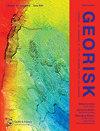饱和条件下随堤防水力导率及地基特性变化的堤防溢入渗侵蚀试验研究
IF 4.8
3区 工程技术
Q1 ENGINEERING, GEOLOGICAL
Georisk-Assessment and Management of Risk for Engineered Systems and Geohazards
Pub Date : 2023-07-25
DOI:10.3390/geohazards4030016
引用次数: 0
摘要
研究了入渗和溢流过程中的侵蚀,并考虑了不同粒度和水力导电性;在饱和条件下进行了4例实验。讨论了在溢流实验中了解流态的重要性,包括其独特的流动特征、剪切应力和侵蚀机制,以评估堤防破坏的潜力。在入渗试验中,堤防边坡的破坏机制是由于管道的作用而逐渐坍塌,随后液化增加和剪切应力损失,破坏的进展取决于地基材料的渗透性和抗剪强度。入渗试验表明,破坏速率随地基材料的渗透性而变化。在IO-E7-F5堤防中,堤堤中有7号砂,地基中有5号砂(渗透性较低),破坏速度较慢且有限。大约90分钟后,下游65%的斜坡坍塌,为采取应对措施留出了更多时间。另一方面,在IO-E8-F4的情况下,路基中有8号砂,地基中有4号砂(水导率更高),破坏迅速而广泛。整个下游坡面在18分钟内坍塌,坍塌幅度达到防洪堤波峰的75%。这些发现强调需要采取积极措施来加强堤坝的脆弱部分,减少大面积破坏的风险。本文章由计算机程序翻译,如有差异,请以英文原文为准。
Experimental Investigation of Levee Erosion during Overflow and Infiltration with Varied Hydraulic Conductivities of Levee and Foundation Properties in Saturated Conditions
This study investigated erosion during infiltration and overflow events and considered different grain sizes and hydraulic conductivity properties; four experimental cases were conducted under saturated conditions. The importance of understanding flow regimes during overflow experiments including their distinct flow characteristics, shear stresses, and erosion mechanisms in assessing the potential for levee failure are discussed. The failure mechanism of levee slopes during infiltration experiments involves progressive collapse due to piping followed by increased liquefaction and loss of shear stress, with the failure progression dependent on the permeability of the foundation material and shear strength. The infiltration experiments illustrate that the rate of failure varied based on the permeability of the foundation material. In the case of IO-E7-F5, where the levee had No. 7 sand in the embankment and No. 5 sand in the foundation (lower permeability), the failure was slower and limited. It took around 90 min for 65% of the downstream slope to fail, allowing more time for response measures. On the other hand, in the case of IO-E8-F4, with No. 8 sand in the embankment and No. 4 sand in the foundation (higher hydraulic conductivity), the failure was rapid and extensive. The whole downstream slope failed within just 18 min, and the collapse extended to 75% of the levee crest. These findings emphasize the need for proactive measures to strengthen vulnerable sections of levees and reduce the risk of extensive failure.
求助全文
通过发布文献求助,成功后即可免费获取论文全文。
去求助
来源期刊
CiteScore
8.70
自引率
10.40%
发文量
31
期刊介绍:
Georisk covers many diversified but interlinked areas of active research and practice, such as geohazards (earthquakes, landslides, avalanches, rockfalls, tsunamis, etc.), safety of engineered systems (dams, buildings, offshore structures, lifelines, etc.), environmental risk, seismic risk, reliability-based design and code calibration, geostatistics, decision analyses, structural reliability, maintenance and life cycle performance, risk and vulnerability, hazard mapping, loss assessment (economic, social, environmental, etc.), GIS databases, remote sensing, and many other related disciplines. The underlying theme is that uncertainties associated with geomaterials (soils, rocks), geologic processes, and possible subsequent treatments, are usually large and complex and these uncertainties play an indispensable role in the risk assessment and management of engineered and natural systems. Significant theoretical and practical challenges remain on quantifying these uncertainties and developing defensible risk management methodologies that are acceptable to decision makers and stakeholders. Many opportunities to leverage on the rapid advancement in Bayesian analysis, machine learning, artificial intelligence, and other data-driven methods also exist, which can greatly enhance our decision-making abilities. The basic goal of this international peer-reviewed journal is to provide a multi-disciplinary scientific forum for cross fertilization of ideas between interested parties working on various aspects of georisk to advance the state-of-the-art and the state-of-the-practice.

 求助内容:
求助内容: 应助结果提醒方式:
应助结果提醒方式:


